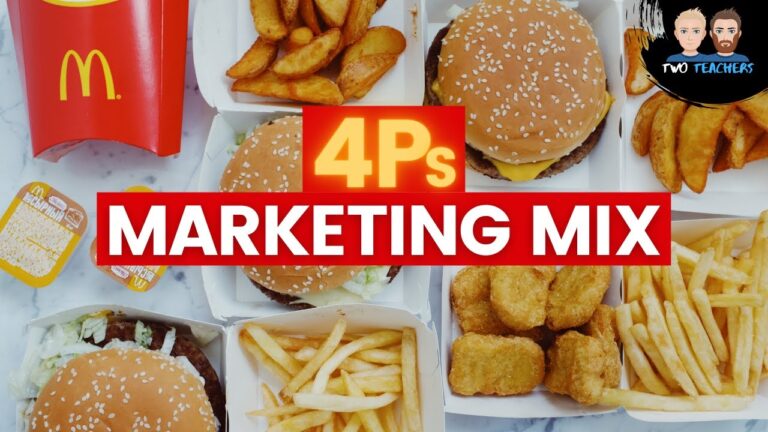Understanding Marketing Mix 4Ps with Best Business Use Cases – Mc Donalds, iPhone, Starbucks, Nestle, Coca Cola
This Guide is the ultimate video collection of Use Cases of Marketing Mix of different brands. Watch each one of those below to understand how 4 Ps of Marketing apply to each one of those.
Public Information about 4Ps of Marketing
4 Ps of Marketing typically refer to
- Product
- Price
- Place (Distribution)
- Promotion
Product refers to what the business offers for sale and may include products or services. Product decisions include the “quality, features, benefits, style, design, branding, packaging, services, warranties, guarantees, life cycles, investments and returns”.
4Ps Marketing mix for McDonalds, Coca Cola Starbucks and Apple
Price refers to decisions surrounding “Promo pricing, discount pricing, special offer pricing, credit payment or credit terms”. Price refers to the total cost to customer to acquire the product, and may involve both monetary and psychological costs such as the time and effort spent in acquisition.
Starbucks Marketing Mix Analysis
Place refers to direct or indirect channels to market, geographical distribution channels, retail outlet, location, delivery options storage, inventory, logistics, and order fulfilment.
McDonald Example
Promotion refers to “the marketing communication used to make the offer known to potential customers and persuade them to investigate it further”. Promotion elements include “advertising, public relations, direct selling and sales promotions.”
Nestle Example
History of 4 Ps of Marketing – Product, Price, Promotion, Place
The origins of the 4 Ps can be traced to the late 1940s. The first known mention of a mix has been attributed to a Professor of Marketing at Harvard University, Prof. James Culliton. In 1948, Culliton published an article entitled, The Management of Marketing Costs in which Culliton describes marketers as ‘mixers of ingredients’.
Coca Cola Marketing Mix Example
Some years later, Culliton’s colleague, Professor Neil Borden, published a retrospective article detailing the early history of the marketing mix in which he claims that he was inspired by Culliton’s idea of ‘mixers’, and credits himself with popularising the concept of the ‘marketing mix’.
Marketing Mix 4Ps – Apple iPhone Example
According to Borden’s account, he used the term, ‘marketing mix’ consistently from the late 1940s. For instance, he is known to have used the term ‘marketing mix’ in his presidential address given to the American Marketing Association in 1953.
Although the idea of marketers as ‘mixers of ingredients’ caught on, marketers could not reach any real consensus about what elements should be included in the mix until the 1960s.
The 4 Ps, in its modern form, was first proposed in 1960 by E. Jerome McCarthy; who presented them within a managerial approach that covered analysis, consumer behaviour, market research, market segmentation, and planning. Phillip Kotler, popularised this approach and helped spread the 4 Ps model.McCarthy’s 4 Ps have been widely adopted by both marketing academics and practitioners.
4Ps of Marketing Summary Lesson by a Business Professor
4 Ps of Marketing Mix Comparison Based on Public Information
| Category | Definition/Explanation/Concept | Typical Marketing Decisions |
|---|---|---|
| Product | A product refers to an item that satisfies the consumer’s needs or wants.Products may be tangible (goods) or intangible (services, ideas or experiences). | Product Design – Features, Quality, Product assortment – Product Range, product mix, product lines, Branding, Packaging and Labeling Services (complimentary service, after-sales service, service level)Guarantees and warranties, Returns, Managing products through the Life Cycle |
| Price | Price refers to the amount a customer pays for a product.Price may also be a consumer’s expectation for getting a certain product (e.g. time or effort).Price is the only variable that has implications for revenue.Price is the only part of the marketing mix that talks about the value for the firm.Price also includes Customer Perception | Price Strategy Price tactics Price-setting Allowances – e.g. rebates for distributors Discounts – for customers Payment terms – credit, payment methods |
| Place | Refers to providing customer accessConsiders providing convenience for consumer. | Strategies such as intensive distribution, selective distribution, exclusive distribution, Franchising, Market coverage, Channel member selection and Channel Member relationships, Assortment, Location Decisions, Inventory, Transport, warehousing and logistics |
| Promotion | Promotion refers to marketing communicationsMay comprise elements such as: Advertising, PR, direct marketing and Sales Promotion | Promotional mix – appropriate balance of advertising, PR, direct marketing and sales promotion, Message strategy – what is to be Communicated Channel Media Strategy – how to reach the target audience, Message Frequency – how often to communicate |
View and Read More Here on:
- Marketing
- Business Stories
- Retail Failure Stories
- Startup Failure Stories
- Travel Food Culture
- Retail Articles
- Customer Related Articles


